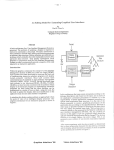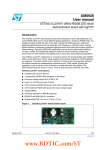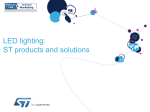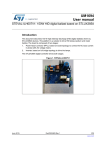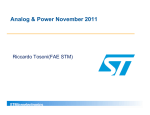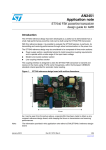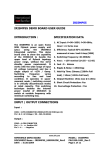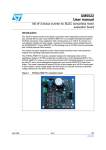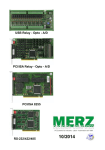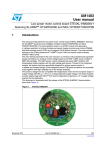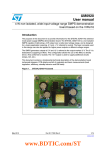Download 80 W offline LED driver with PFC
Transcript
UM0670 User manual 80 W offline LED driver with PFC 1 Introduction The use of high power LEDs in lighting applications is becoming increasingly popular due to rapid improvements in lighting efficiency, longer life, higher reliability and overall cost effectiveness. Dimming functions are more easily implemented in LEDs, and they are more robust and offer wider design flexibility compared to other light sources. For this reason a demonstration board for driving high brightness and power LEDs has been developed. The STEVAL-ILL013V1 demonstration board is an 80 W offline dimmable LED driver with high power factor (PF) intended for fixed number of LEDs, the overall design of which is described in detail in this user manual. The LED current can be set to 350 mA, 700 mA and 1000 mA, using jumpers. Additionally, a dimming function using a PWM (pulse width modulation) signal is implemented as well, allowing the user to set the LED brightness from 0% up to 100%. The demonstration board can be ordered using order code STEVAL-ILL013V1, and is shown in Figure 1. STEVAL-ILL013V1 main features ■ 80 W LED driver ■ 350 mA, 700 mA and 1 A LED current settings ■ High efficiency (~90%) ■ Wide input voltage range: 88 to 265 VAC ■ High power factor: 0.99 for 110 VAC and 0.98 for 230 VAC ■ Universal PWM input for dimming (external board required) ■ Non-isolated SMPS ■ Brightness regulation between 0% and 100% ■ EMI filter implemented ■ EN55015 and EN61000-3-2 compliant Figure 1. August 2009 STEVAL-ILL013V1 demonstration board Doc ID 15327 Rev 2 1/43 www.st.com Contents UM0670 Contents 1 Introduction . . . . . . . . . . . . . . . . . . . . . . . . . . . . . . . . . . . . . . . . . . . . . . . . 1 2 Getting started . . . . . . . . . . . . . . . . . . . . . . . . . . . . . . . . . . . . . . . . . . . . . . 5 3 Design concept . . . . . . . . . . . . . . . . . . . . . . . . . . . . . . . . . . . . . . . . . . . . . 6 4 STEVAL-ILL013V1 technical details . . . . . . . . . . . . . . . . . . . . . . . . . . . . 9 5 Schematic diagram . . . . . . . . . . . . . . . . . . . . . . . . . . . . . . . . . . . . . . . . . 10 6 Bill of material . . . . . . . . . . . . . . . . . . . . . . . . . . . . . . . . . . . . . . . . . . . . . 12 7 STEVAL-ILL013V1 performance . . . . . . . . . . . . . . . . . . . . . . . . . . . . . . . 14 8 Dimming function . . . . . . . . . . . . . . . . . . . . . . . . . . . . . . . . . . . . . . . . . . 17 9 Measurement . . . . . . . . . . . . . . . . . . . . . . . . . . . . . . . . . . . . . . . . . . . . . . 19 10 11 9.1 Output waveform measurement . . . . . . . . . . . . . . . . . . . . . . . . . . . . . . . . 19 9.2 Power MOSFET turn ON and OFF time . . . . . . . . . . . . . . . . . . . . . . . . . . 22 9.3 LED current ripple reduction . . . . . . . . . . . . . . . . . . . . . . . . . . . . . . . . . . 22 9.4 Standard EN61000-3-2 measurement . . . . . . . . . . . . . . . . . . . . . . . . . . . 23 9.5 EMI measurement (EN55015) . . . . . . . . . . . . . . . . . . . . . . . . . . . . . . . . . 26 Design features . . . . . . . . . . . . . . . . . . . . . . . . . . . . . . . . . . . . . . . . . . . . 32 10.1 Proper startup circuit design . . . . . . . . . . . . . . . . . . . . . . . . . . . . . . . . . . 32 10.2 Zero dimming design implementation . . . . . . . . . . . . . . . . . . . . . . . . . . . 33 References and related materials . . . . . . . . . . . . . . . . . . . . . . . . . . . . . 36 Appendix A Design calculation . . . . . . . . . . . . . . . . . . . . . . . . . . . . . . . . . . . . . . . 37 A.1 12 2/43 Design specifications for a modified buck convertor . . . . . . . . . . . . . . . . . 37 Revision history . . . . . . . . . . . . . . . . . . . . . . . . . . . . . . . . . . . . . . . . . . . 42 Doc ID 15327 Rev 2 UM0670 List of tables List of tables Table 1. Table 2. Table 3. Table 4. LED values for different output currents . . . . . . . . . . . . . . . . . . . . . . Output LED current adjustment on the demonstration board . . . . . . STEVAL-ILL013V1 demonstration board bill of material . . . . . . . . . Document revision history . . . . . . . . . . . . . . . . . . . . . . . . . . . . . . . . Doc ID 15327 Rev 2 ....... ....... ....... ....... ...... ...... ...... ...... .....5 .....5 . . . . 12 . . . . 42 3/43 UM0670 List of figures List of figures Figure 1. Figure 2. Figure 3. Figure 4. Figure 5. Figure 6. Figure 7. Figure 8. Figure 9. Figure 10. Figure 11. Figure 12. Figure 13. Figure 14. Figure 15. Figure 16. Figure 17. Figure 18. Figure 19. Figure 20. Figure 21. Figure 22. Figure 23. Figure 24. Figure 25. Figure 26. Figure 27. Figure 28. Figure 29. Figure 30. Figure 31. Figure 32. Figure 33. Figure 34. Figure 35. Figure 36. Figure 37. Figure 38. Figure 39. Figure 40. Figure 41. Figure 42. Figure 43. STEVAL-ILL013V1 demonstration board . . . . . . . . . . . . . . . . . . . . . . . . . . . . . . . . . . . . . . . 1 STEVAL-ILL013V1 block schematic . . . . . . . . . . . . . . . . . . . . . . . . . . . . . . . . . . . . . . . . . . . 6 High PF boost converter design concept . . . . . . . . . . . . . . . . . . . . . . . . . . . . . . . . . . . . . . . 7 Modified buck converter with dimming design concept. . . . . . . . . . . . . . . . . . . . . . . . . . . . . 8 STEVAL-ILL013V1 with PWM module . . . . . . . . . . . . . . . . . . . . . . . . . . . . . . . . . . . . . . . . . 9 High PFC boost converter with the L6562A . . . . . . . . . . . . . . . . . . . . . . . . . . . . . . . . . . . . 10 Modified buck converter with the L6562A . . . . . . . . . . . . . . . . . . . . . . . . . . . . . . . . . . . . . . 11 Efficiency over the whole input voltage range . . . . . . . . . . . . . . . . . . . . . . . . . . . . . . . . . . 14 Power factor for wide input voltage range . . . . . . . . . . . . . . . . . . . . . . . . . . . . . . . . . . . . . 15 Detailed power factor for wide input voltage range. . . . . . . . . . . . . . . . . . . . . . . . . . . . . . . 15 Total harmonic distortion for wide input voltage range . . . . . . . . . . . . . . . . . . . . . . . . . . . . 16 Output LED current dimming capability . . . . . . . . . . . . . . . . . . . . . . . . . . . . . . . . . . . . . . . 18 Output LED current waveform (ILED = 350 mA) . . . . . . . . . . . . . . . . . . . . . . . . . . . . . . . . . 19 Output LED current for different LED voltages (ILED = 350 mA). . . . . . . . . . . . . . . . . . . . . 20 Output LED current waveforms (ILED = 700 mA) . . . . . . . . . . . . . . . . . . . . . . . . . . . . . . . . 20 Output LED current for different LED voltage (ILED = 700 mA). . . . . . . . . . . . . . . . . . . . . . 21 Output LED current waveform (ILED = 1000 mA) . . . . . . . . . . . . . . . . . . . . . . . . . . . . . . . . 21 Output LED current for different LED voltage (ILED = 1000 mA). . . . . . . . . . . . . . . . . . . . . 22 Power MOSFET turn ON and OFF measurement . . . . . . . . . . . . . . . . . . . . . . . . . . . . . . . 22 LED current ripple for the 100 nF output capacitor . . . . . . . . . . . . . . . . . . . . . . . . . . . . . . . 23 EN61000-3-2 analysis for LED current of 350 mA and VIN from 85 V to 160 VAC . . . . . . 23 EN61000-3-2 analysis for LED current of 350 mA and VIN from 180 V to 265 VAC . . . . . 24 EN61000-3-2 analysis for LED current of 700 mA and VIN from 85 V to 160 VAC . . . . . . 24 EN61000-3-2 analysis for LED current of 700 mA and VIN from 180 V to 265 VAC . . . . . 24 EN61000-3-2 analysis for LED current of 1000 mA and VIN from 85 V to 160 VAC . . . . . 25 EN61000-3-2 analysis for LED current of 1000 mA and VIN from 180 V to 265 VAC . . . . 25 Average limit measurement from 150 kHz to 30 MHz (ILED = 350 mA) . . . . . . . . . . . . . . . 26 Quasi-peak limit measurement from 9 kHz to 150 kHz (ILED = 350 mA) . . . . . . . . . . . . . . 26 Quasi-peak limit measurement from 150 kHz to 30 MHz (ILED = 350 mA). . . . . . . . . . . . . 27 Average limit measurement from 150 kHz to 30 MHz (ILED = 700 mA) . . . . . . . . . . . . . . . 27 Quasi-peak limit measurement from 9 kHz to 150 kHz (ILED = 700 mA) . . . . . . . . . . . . . . 28 Quasi-peak limit measurement from 150 kHz to 30 MHz (ILED = 700 mA). . . . . . . . . . . . . 28 Average limit measurement from 150 kHz to 30 MHz (ILED = 1000 mA) . . . . . . . . . . . . . . 29 Quasi-peak limit measurement from 9 kHz to 150 kHz (ILED = 1000 mA) . . . . . . . . . . . . . 29 Quasi-peak limit measurement from 150 kHz to 30 MHz (ILED = 1000 mA). . . . . . . . . . . . 30 Average limit measurement from 150 kHz to 30 MHz (ILED = 0 mA) . . . . . . . . . . . . . . . . . 30 Quasi-peak limit measurement from 9 kHz to 150 kHz (ILED = 0 mA) . . . . . . . . . . . . . . . . 31 Quasi-peak limit measurement from 150 kHz to 30 MHz (ILED = 0 mA) . . . . . . . . . . . . . . . 31 Proper startup circuit design . . . . . . . . . . . . . . . . . . . . . . . . . . . . . . . . . . . . . . . . . . . . . . . . 32 Proper startup using diode D104 and capacitor C110 . . . . . . . . . . . . . . . . . . . . . . . . . . . . 33 Improper startup without using diode D104 and capacitor C110 . . . . . . . . . . . . . . . . . . . . 33 Design improvement allowing zero dimming . . . . . . . . . . . . . . . . . . . . . . . . . . . . . . . . . . . 34 Voltage on capacitor C110 and output bus voltage of 400 V . . . . . . . . . . . . . . . . . . . . . . . 35 Doc ID 15327 Rev 2 4/43 Getting started 2 UM0670 Getting started This section is intended to help designers begin evaluating the board quickly, describing how the board should be connected with the load and how the jumpers adjust the output LED current. As mentioned in the introduction, the board has a nominal output power of 80 W and the output LED current can be set to 350 mA, 700 mA or 1 A. The LEDs are connected to one string. Basically, this means if the LED current is set to 350 mA, then the LED voltage should be approximately 228 V in order to provide output power of 80 W. If the LED current is set to 700 mA, then the LED voltage should be around 114 V. Finally, if the LED current is set to 1 A, then the LED voltage should be about 80 V. Assuming that a high brightness LED has (typically) a 3.5 V forward voltage drop, the number of LEDs for the 350 mA output current is 65, for the 700 mA output current it is 32 and for the output current of 1 A it is 23 (see Table 1). Of course, designers must recalculate the number of LEDs in cases where the LED has a forward voltage drop other than 3.5 V. If the output LED voltage is different than that given in Table 1, output LED current precision will be influenced so is recommended that the total forward voltage drop across all the LEDs is as close as possible to the calculated output voltages shown in Table 1. Connect the LED string to the board using connector J2 or J3, being careful to observe the correct LED polarity (anode + and cathode –). Set the output LED current to 350 mA, 700 mA or 1 A, based on how many LEDs are connected to the output. The output LED current is set using jumpers JP1, JP2, JP3 and JP4, in accordance with the connection settings specified in Table 2. It is not necessary to connect a dimming module with a PWM signal, because if the module is not used the LED brightness is set to maximum level (100% brightness). Finally, connect an input voltage to the demonstration board between 88 VAC and 265 VAC, and the LEDs begin illuminating. Note: The LEDs cannot be connected during operation, when the input voltage is connected to the demonstration board. This is because in this case the output capacitor C208 = 0.47 µF is charged to 400 V and can cause uncontrolled peak LED current. Table 1. Output LED current [mA] Output LED voltage [V] Number of LEDs for forward voltage drop 3.5 V 350 228 65 700 114 32 1000 80 23 Table 2. 5/43 LED values for different output currents Output LED current adjustment on the demonstration board Jumper 350 mA 700 mA 1000 mA JP1 Not connected Connected Not connected JP2 Not connected Connected Not connected JP3 Not connected Not connected Connected JP4 Not connected Not connected Connected Doc ID 15327 Rev 2 UM0670 3 Design concept Design concept The STEVAL-ILL013V1 block schematic is illustrated in Figure 2. As shown, the design is divided into two main topologies. The first is a high PF (power factor) boost converter, and the second is a modified buck converter. As an additional board, any external PWM generator can be used for LED brightness regulation. If no PWM generator is connected to the STEVAL-ILL013V1, the LED brightness is pre-adjusted to 100%. There are two main reasons the high PF boost converter is designed on the STEVALILL013V1 demonstration board. The first is the requirement for lighting equipment with an input active power higher than 25 W to comply with standard EN61000-3-2 (harmonic current distortion). Thanks to the high PF converter, compliance to the standard is achieved with no difficulty. The second reason is that a high input voltage (in this case 400 V) is needed for the modified buck converter, because it is, in fact, a buck converter and thus the input voltage must be higher than the output voltage. The output LED voltage can be up to 228 V, as was shown in Table 1. An additional advantage of the high PF converter is its wide input voltage range. This allows the demonstration board to be used either in either the European or US markets. A more detailed description of the high PF boost converter is provided in the EVL6562A-TM-80W data brief (see Section 11: References and related materials: 1). The second converter is designed as a constant current source, as it ensures the best lighting performance from the LEDs. Concerning the topology, the “modified buck” has been chosen, “modified” insofar as the power switch is connected to ground (instead of the highside switch, as in a standard buck topology) and therefore it is easier to control the switch. The design uses a FOT (fixed off-time) network, operating in CCM (continuous conduction mode) and thanks to this principle the overall solution is very simple and cost effective. All equations needed for proper modified buck converter design are described in application note AN2928 (see Section 11: References and related materials: 2). Figure 2. STEVAL-ILL013V1 block schematic STEVAL- ILL013V1 HIGH POWER FACTOR BOOST CONVERTER MODIFIED BUCK CONVERTER STTH1L06 VIN = 88 V to 265 V AC 80 W LOAD 400 V Input filter STPSC806D STP8NM50FP PF controller L6562A PF controller L6562A STF9NM50N EXTERNAL PWM GENERATOR Microcontroller ST7LITEU05 Bright regulation AM00400 Doc ID 15327 Rev 2 6/43 Design concept UM0670 Figure 3 illustrates a high PF boost converter design concept. Two additional features are implemented in the application and these improvements are shown in the blue segments. The first improves circuit behavior during startup (see Section 10.1 for a description) and the second allows the dimming of the LED down to 0%, or no LED brightness (description provided in Section 10.2). Figure 4 shows the design concept of a modified buck converter with a dimming function. The output LED current is adjusted by setting the proper sense resistor size via the jumpers (to adjust maximum LED current), together with the proper setting of the capacitor used in the FOT network (adjust minimum LED current). The external PWM generator provides a PWM signal between 0 and 100% for brightness regulation. This signal is connected through a diode to the current sense pin and allows control of LED brightness. Figure 3. High PF boost converter design concept Vc = 16 V Supplying PWM generator with ST7LITEU05 Supplying L6562A in modified BUCK converter STTH1L06 VIN = 88 V to 265 V AC ZCD COMP INV VCC L6562A GD MULT GND CS D104 STP8NM50FP VOUT = 400 V C110 Input EMI filter C107 Proper startup Allowing 0% dimming AM00413 7/43 Doc ID 15327 Rev 2 UM0670 Design concept Figure 4. Modified buck converter with dimming design concept Vc = 16 V generated by the first converter VIN = 400 V generated by the first converter Additional board STPSC806D 80 W LEDs L78L33 VDD VSS ST7LITEU05 CLKIN PWM NC ICCCLK VCC INV L6562A STF9NM50N GD COMP MULT GND CS ZCD RESET AIN2 ICC programming External module for brightness regulation Fixed off-time network 350 mA 700 mA 1A PWM signal 0% to 100% AM00414 Doc ID 15327 Rev 2 8/43 STEVAL-ILL013V1 technical details 4 STEVAL-ILL013V1 technical details ● 80 W LED driver ● 350 mA, 700 mA and 1 A LED current settings ● PF = 0.99 with VIN = 110 V or PF = 0.98 with VIN = 230 V ● THD (total harmonic distortion) = 4.6 and VIN = 110 V or THD = 10.3 and VIN = 230 V ● High PFC boost converter operating in transition mode ● Modified buck converter working in CCM and using FOT network ● Switching frequency f = 125 kHz / 350 mA (modified buck converter) ● Switching frequency f = 69 kHz / 700 mA (modified buck converter) ● Switching frequency f = 55 kHz / 1000 mA (modified buck converter) ● The same inductor and transformer core used (E25) ● Supply voltage provided for external PWM generator ● Board size: 130 mm x 60 mm x 27 mm ● Optional external PWM generator (non isolated) ● Full brightness if PWM generator is not connected ● Two output connectors for LEDs ● High efficiency (~90%) ● Wide input voltage range: 88 V to 265 VAC ● Brightness regulation between 0% and 100% ● EMI filter implemented ● EN55015 and EN61000-3-2 tested Figure 5. 9/43 UM0670 STEVAL-ILL013V1 with PWM module Doc ID 15327 Rev 2 J1 F1 2A Doc ID 15327 Rev 2 C101 R102 1 MΩ C103 220 nF 1 MΩ R103 C109 R106 12 nF 270 kΩ C108 12 nF R109 47 Ω R108 47 Ω 10 9 8 7 6 T101 STTH1L06 D103 R118 1 MΩ R123 R126 330 kΩ 20 kΩ 400 V 16 V 1 MΩ D102 R112 R113 R114 R120 R121 1 Ω 1 Ω 1 Ω 15 kΩ 82 kΩ AM00402 1 23 5 C112 R122 150 nF R119 R107 R110 BR1 0Ω R117 R124 1 MΩ 270 kΩ 47 kΩ 22 kΩ 330 kΩ R127 R104 20 kΩ U101 C111 L6562A C113 5 2 2200 nF D104 Q101 R125 3 STP8NM50FP 8 ZCD COMP 1 C104 330 kΩ V CC INV R115 47uF 1 220 2 Q102 3 7 / 450 V nF MULT GD C110 4 33 Ω Heatsink BUX83 33 µF GND CS C106 R105 R116 D101 6 4 100 nF 15 kΩ 47 kΩ R128 C105 18 V 10nF 43 kΩ C107 R111 10 µF 0Ω CMC2x 22 mH / 1 A TR1 1nF / Y1 / 250 V AC C102 470 nF NTC 10 Ω Secondary: 11 turns 1 x 0.3 mm Primary: 105 turns 2 x 0.3 mm 1.5 mm gap, N67 Figure 6. R101 1 MΩ 5 E 25 x 13 x 7 UM0670 Schematic diagram Schematic diagram High PFC boost converter with the L6562A 10/43 11/43 J4 10 9 8 7 6 5 4 3 2 1 PWM dimming signal Doc ID 15327 Rev 2 1N4148 D204 3.9 KΩ R209 4 3 2 1 R208 47 KΩ VCC CS 330 pF C207 1 KΩ R207 ZCD MULT GND COMP GD INV U201 L6562A 5 6 7 8 R203 3.9 KΩ 220 pF / 63V C203 22 µF / 35 V C204 390 pF / 63 V R202 1 KΩ 1N4148 33 Ω D201 R201 100 nF C202 1 C205 820 pF / 63 V 4 1 R205 1.5 Ω / 0.6 W 2.2 Ω / 0.6 W 2.7 Ω / 0.6 W R204 R206 STTH1L06A D203 1.6 mH / 172 turns JP4 JP2 1 JUMPER 2 JUMPER 2 C208 0.47 µF / 450 V L201 Q201 1 STF9NM50N Heatsink 1.5 nF / 63 V C206 JP1 JP3 2 JUMPER 2 JUMPER 1 2 3 D202 STPSC806D 400 V AM00403 1 2 3 4 5 6 1 2 J3 J2 – + – + Figure 7. C201 16 V Schematic diagram UM0670 Modified buck converter with the L6562A UM0670 Bill of material 6 Bill of material Table 3. STEVAL-ILL013V1 demonstration board bill of material (1) I Q Reference Part Note Manufacturer Order code 1 1 J1 Socket Input socket 2 1 F1 Fuse 2.5 A / 250 V 3 1 F1 Fuse socket Socket 4 1 NTC 10 Ω NTC thermistor EPCOS B57235S100M 5 1 TR1 2 x 22 mH / 1 A Common mode choke EPCOS B82732R2102B030 6 1 BR1 1 A / 250 V Diode bridge 7 1 C101 1 nF / 250 VAC Y1 capacitor Murata Manufacturing DE1E3KX102MA5B Co., Ltd. 8 1 C102 470 nF / 265 VAC X2 capacitor EPCOS B32922C3474K 9 2 C103, C104 220 nF / 265 VAC X2 capacitor EPCOS B32922C3224M 10 1 C105 10 nF / 63 V SMD capacitor 1206 11 2 C106, C202 100 nF / 63 V SMD capacitor 1206 12 1 C107 10 µF / 35 V Electrolytic capacitor 13 2 C108, C109 12 nF / 63 V SMD capacitor 1206 14 1 C110 33 µF / 35 V Electrolytic capacitor 15 1 C111 2200 nF / 25 V X7R SMD 1206 ceramic capacitor AVX 12063C225KAT2A 16 1 C112 150 nF / 50 V SMD capacitor 1206 17 1 C113 47 µF / 450 V Electrolytic capacitor EPCOS B43501A5476M000 18 1 D101 18 V / 0.5 W Zener diode 19 4 D102, D104, 1N4148 D201, D204 SMD diode 20 1 D103 STTH1L06U SMB package 21 2 U101, U201 L6562A PFC controller 1 MΩ SMD resistors 1206 23 1 R105 15 kΩ SMD resistors 1206 24 2 R106, R107 270 kΩ SMD resistors 1206 25 2 R108, R109 47 Ω SMD resistors 1206 22 4 26 3 R101, R102 R103, R104 R110, R116, 47 kΩ R208 27 2 R111, R122 28 3 0Ω R112, R113, 1 Ω / 1% R114 29 2 R115, R201 33 Ω STMicroelectronics STMicroelectronics STTH1L06U L6562AD SMD resistors 1206 SMD resistors 1206 SMD resistors 1206 SMD resistors 1206 Doc ID 15327 Rev 2 12/43 Bill of material Table 3. I Q UM0670 STEVAL-ILL013V1 demonstration board bill of material (continued)(1) Reference Part Note Manufacturer Order code 30 1 R117 22 kΩ SMD resistors 1206 31 2 R118, R119 1 MΩ / 1% Axial resistor 0.6 W / 1% 32 1 R120 15 kΩ / 1% SMD resistors 1206 33 1 R121 82 kΩ / 1% SMD resistors 1206 330 kΩ SMD resistors 1206 35 2 R126, R127 20 kΩ Axial resistor 0.6 W 36 1 R128 43 kΩ SMD resistor 1206 37 1 T101 Transformer E25/13/7 1.5 mm gap , N67 Primary: 105 turns 2 x 0.3 Secondary: 11 turns 1 x 0.3 38 1 Q101 STP8NM50 Power MOSFET STMicroelectronics STP8NM50FP 39 1 Q102 BUX87 Bipolar transistor STMicroelectronics BUX87 34 3 R123, R124 R125 40 2 Heat sink Heat sink for MOSFETs 41 2 R202, R207 1kΩ SMD resistors 1206 42 2 R203, R209 3900 Ω SMD resistors 1206 43 1 R204 1.5 Ω / 0.6 W Axial resistor 44 1 R205 2.7 Ω / 0.6 W Axial resistor 45 1 R206 2.2 Ω / 0.6 W Axial resistor 46 1 C201 22 µF / 35 V Electrolytic cap 47 1 C203 220 pF / 63 V SMD capacitor 1206 48 1 C204 390 pF / 63 V SMD capacitor 1206 49 1 C205 820 pF / 63 V SMD capacitor 1206 50 1 C206 1.5 nF / 63 V SMD capacitor 1206 51 1 C207 330 pF / 63 V SMD capacitor 1206 52 1 C208 0.47 µF / 450 V Electrolytic capacitor EPCOS B43827A5474M000 53 1 D202 STPSC806D Silicon carbide diode STMicroelectronics STPSC806D 54 1 D203 STTH1L06A SMA package STMicroelectronics STTH1L06A Jumper Two pin connector 56 2 JPJ1, JPJ2 Jumper Jumpers 57 1 J2 Socket Output socket 58 1 J3 Socket Output socket 59 1 J4 Socket PWM socket 60 1 Q201 STF9NM50N Power MOSFET STMicroelectronics STF9NM50N 61 1 L201 1.6 mH E25/13/7 2 mm gap N67, 172 turns 1 x 0.28 55 4 JP1, JP2 JP3, JP4 1. The power MOSFET STF9NM50N can be replaced by STF10NM60N. 13/43 Doc ID 15327 Rev 2 UM0670 7 STEVAL-ILL013V1 performance STEVAL-ILL013V1 performance Figure 8 shows the efficiency of the STEVAL-ILL013V1 (measured also with an external PWM generator) for the output LED current 350 mA, 700 mA and 1 A, over the entire input voltage range. Measured efficiency for the input voltage of 230 V was above 90% (90.49% for the 350 mA output LED current, 90.53% for the 700 mA output LED current, and 90.3% for the 1 A output LED current) Efficiency for the input voltage of 110 V was above 87% (88.05% for the 350 mA output LED current, 88.2% for the 700 mA output LED current and 87.37% for the output LED current of 1 A). Measured PF for the output LED current of 350 mA, 700 mA and 1 A is shown in Figure 9 and Figure 10. PF for the input voltage of 110 VAC is 0.99, and 0.98 for the input voltage of 230 VAC. THD is demonstrated in Figure 11, and as it can be observed is below 12% over the whole input voltage range. Note: LE UW E3B OSTAR® LEDs from OSRAM were used as the load (see Section 11: References and related materials: 6.). Figure 8. Efficiency over the whole input voltage range 100.00 90.00 80.00 70.00 Efficiency [%] 60.00 700 mA at 6 LEDs 50.00 350 mA at 12 LEDs 40.00 1 A at 4 LEDs 30.00 20.00 10.00 0.00 85 100 110 120 140 160 180 200 220 230 240 265 Input v oltage [V] AM00395 Doc ID 15327 Rev 2 14/43 STEVAL-ILL013V1 performance Figure 9. UM0670 Power factor for wide input voltage range 1 0.8 700 mA at 6 LEDs 0.6 350 mA at 12 LEDs Power factor [-] 1 A at 4 LEDs 0.4 0.2 0 85 100 110 120 140 160 180 200 220 230 240 265 Input v oltage [V] AM00397 Figure 10. Detailed power factor for wide input voltage range 1 0.99 0.98 700 mA at 6 LEDs Power factor [-] 350 mA at 12 LEDs 1 A at 4 LEDs 0.97 0.96 0.95 85 100 110 120 140 160 180 200 220 230 240 265 Input v oltage [V] AM00396 15/43 Doc ID 15327 Rev 2 UM0670 STEVAL-ILL013V1 performance Figure 11. Total harmonic distortion for wide input voltage range 12.00 10.00 8.00 700 mA at 6 LEDs THD [%] 350 mA at 12 LEDs 6.00 1 A at 4 LEDs 4.00 2.00 0.00 85 100 110 120 140 160 180 200 220 230 240 265 Input v oltage [V] AM00398 Doc ID 15327 Rev 2 16/43 Dimming function 8 UM0670 Dimming function LEDs as a light source are very often used in applications where the brightness regulation is required. Their biggest advantage is that their minimum brightness can be easily regulated by changing their current, and they are stable even at very low brightness. Generally, there are two basic concepts regarding how the brightness is regulated. The first is called “analog dimming”, which means that the brightness is regulated by changing the continuous forward LED current. This concept is not used on the STEVAL-ILL013V1. The second solution is to use a low frequency (~200 Hz) PWM signal and change the brightness by pulse width modulation. This is the approach used in the design of the STEVAL-ILL013V1. Any external PWM generator can be used for brightness regulation, but it should be taken into account that the STEVAL-ILL013V1 is not isolated. In order to demonstrate the dimming function on the STEVAL-ILL013V1, an external PWM generator using STMicroelectronics’ ST7LITEU05 microcontroller was connected to the board, and the output LED current was measured. The microcontroller generates a PWM signal with a frequency of 250 Hz. The duty cycle is set by a potentiometer from 0% up to 100%.The result with duty cycles of 50%, 10% and 2% is shown in Figure 12. The input voltage was, in this case, 230 VAC and the output LED current was set to 350 mA. It is also possible to achieve LED brightness regulation below 2%. In this case the nominal LED current is slightly decreased. 17/43 Doc ID 15327 Rev 2 UM0670 Dimming function Figure 12. Output LED current dimming capability Doc ID 15327 Rev 2 18/43 Measurement UM0670 9 Measurement 9.1 Output waveform measurement Figure 13 shows the output LED current waveform. The LED current was set to 350 mA and, as shown, the current ripple is 92 mA and the switching frequency for the modified buck converter is 125 kHz. The input voltage was 230 VAC and 12 LEDs were used as the load (OSTAR LED LE UW E3B; see Section 11: References and related materials 6). The output LED current slightly varies with the output voltage, as explained in detail in application note AN2928, (Section 11: References and related materials 2) and therefore this design is optimal for a fixed number of LEDs. The output LED current accuracy for different LED voltages is demonstrated in Figure 14. Figure 13. Output LED current waveform (ILED = 350 mA) 19/43 Doc ID 15327 Rev 2 UM0670 Measurement Figure 14. Output LED current for different LED voltages (ILED = 350 mA) VLED v s. ILED for nominal LED current 350 mA 450 400 350 LED 300 current 250 [mA] 200 350 mA 150 100 50 0 174 193 211 230 250 LED voltage [V] AM00399 Figure 15 shows the output LED current waveform for the LED current of 700 mA. The current ripple is, in this case, 333 mA and the switching frequency for the modified buck converter is 69 kHz. The input voltage was 230 AC and 6 LEDs were used as the load (OSTAR LED LE UW E3B see Section 11: References and related materials: 6). The output LED current accuracy for the different LED voltages is shown in Figure 16. Figure 15. Output LED current waveforms (ILED = 700 mA) Doc ID 15327 Rev 2 20/43 Measurement UM0670 Figure 16. Output LED current for different LED voltage (ILED = 700 mA) VLED v s. ILED for nominal LED current 700 mA 800 700 600 LED 500 current [mA] 400 700 mA 300 200 100 0 82 101 121 139 LED voltage [V] AM00404 Figure 17 shows the output LED current waveform for the output LED current of 1000 mA. The current ripple is 433 mA and the switching frequency for the modified buck converter is 55 kHz. The input voltage was 230 VAC and 4 LEDs were used as the load (OSTAR LED LE UW E3B see Section 11: References and related materials: 6). The output LED current accuracy for the different LED voltages is shown in Figure 18. Figure 17. Output LED current waveform (ILED = 1000 mA) 21/43 Doc ID 15327 Rev 2 UM0670 Measurement Figure 18. Output LED current for different LED voltage (ILED = 1000 mA) VLED v s. ILED for nominal LED current 1 A 1200 1000 LED 800 current [mA] 600 1A 400 200 0 63 84 103 122 LED voltage [V] AM00405 9.2 Power MOSFET turn ON and OFF time The power MOSFET turn ON and OFF time is shown in Figure 19. Turn ON time is approximately 50 ns and turn OFF time is approximately 120 ns (OFF time is used in Equation 13 in the appendix). Figure 19. Power MOSFET turn ON and OFF measurement 9.3 LED current ripple reduction The output LED current ripple can be reduced by increasing the output capacitor size. For example, inductor current ripple is 400 mA for the 100 nF / 450 V output capacitor, as shown in Figure 20. Thanks to the larger 470 nF capacitor used on the STEVAL-ILL013V1, the Doc ID 15327 Rev 2 22/43 Measurement UM0670 output current ripple is reduced to 92 mA (see Figure 13). However, there are some limitations for the capacitors used in dimmable applications, as capacitors that are too large cause a decrease in dimming resolution (minimum duty cycle is limited). The 470 nF capacitor used on the STEVAL-ILL013V1 is a good compromise between lower output current ripple and good dimming resolution, as illustrated in Figure 12. Figure 20. LED current ripple for the 100 nF output capacitor 9.4 Standard EN61000-3-2 measurement Figure 21. EN61000-3-2 analysis for LED current of 350 mA and VIN from 85 V to 160 VAC EN61000-3-2 analysis for LED current 350 mA at 12 LEDs VIN from 85 V to 160 V AC 1200 1000 800 Current 600 [mA] Real Limits 400 200 0 1 3 5 7 9 85 V 1 3 5 7 9 1 3 5 7 9 1 3 5 7 9 1 3 5 7 9 1 3 5 7 9 100 V 110 V 120 V 140 V 160 V AM00406 23/43 Doc ID 15327 Rev 2 UM0670 Measurement Figure 22. EN61000-3-2 analysis for LED current of 350 mA and VIN from 180 V to 265 VAC EN61000-3-2 analysis for LED current 350 mA at 12 LEDs VIN from 180 V to 265 V AC 600 500 Current 400 [mA] 300 Real Limits 200 100 0 1 3 5 7 9 180 V 1 3 5 7 9 1 3 5 7 9 1 3 5 7 9 1 3 5 7 9 1 3 5 7 9 200 V 220 V 230 V 240 V 260V AM00407 Figure 23. EN61000-3-2 analysis for LED current of 700 mA and VIN from 85 V to 160 VAC EN61000-3-2 analysis for LED current 700 mA at 6 LEDs VIN from 85 V to 160 V AC 1200 1000 800 Current [mA] 600 Real Limits 400 200 0 1 3 5 7 9 1 3 5 7 9 1 3 5 7 9 1 3 5 7 9 1 3 5 7 9 1 3 5 7 9 85 V 100 V 110 V 120 V 140 V 160 V AM00408 Figure 24. EN61000-3-2 analysis for LED current of 700 mA and VIN from 180 V to 265 VAC EN61000-3-2 analysis for LED current 700 mA at 6 LEDs VIN from 180 V to 265 V AC 600 500 400 Current [mA] 300 Real Limits 200 100 0 1 3 5 7 9 1 3 5 7 9 1 3 5 7 9 180 V 200 V 220 V 1 3 5 7 9 230 V 1 3 5 7 9 1 3 5 7 9 240 V 260 V AM00409 Doc ID 15327 Rev 2 24/43 Measurement UM0670 Figure 25. EN61000-3-2 analysis for LED current of 1000 mA and VIN from 85 V to 160 VAC EN61000-3-2 analysis for LED current 1 A at 4 LEDs VIN from 85 V to 160 V AC 1200 1000 800 Current 600 [mA] Real Limits 400 200 0 1 3 5 7 9 85 V 1 3 5 7 9 1 3 5 7 9 1 3 5 7 9 1 3 5 7 9 1 3 5 7 9 100 V 110 V 120 V 140 V 160 V AM00410 Figure 26. EN61000-3-2 analysis for LED current of 1000 mA and VIN from 180 V to 265 VAC EN61000-3-2 analysis for LED current 1 A at 4 LEDs VIN from 180 V to 265 V AC 600 500 400 Current 300 [mA] Real Limits 200 100 0 1 3 5 7 9 1 3 5 7 9 1 3 5 7 9 1 3 5 7 9 1 3 5 7 9 1 3 5 7 9 180 V 200 V 220 V 230 V 240 V 260 V AM00411 25/43 Doc ID 15327 Rev 2 UM0670 9.5 Measurement EMI measurement (EN55015) Figure 27. Average limit measurement from 150 kHz to 30 MHz (ILED = 350 mA) Figure 28. Quasi-peak limit measurement from 9 kHz to 150 kHz (ILED = 350 mA) Doc ID 15327 Rev 2 26/43 Measurement UM0670 Figure 29. Quasi-peak limit measurement from 150 kHz to 30 MHz (ILED = 350 mA) Figure 30. Average limit measurement from 150 kHz to 30 MHz (ILED = 700 mA) 27/43 Doc ID 15327 Rev 2 UM0670 Measurement Figure 31. Quasi-peak limit measurement from 9 kHz to 150 kHz (ILED = 700 mA) Figure 32. Quasi-peak limit measurement from 150 kHz to 30 MHz (ILED = 700 mA) Doc ID 15327 Rev 2 28/43 Measurement UM0670 Figure 33. Average limit measurement from 150 kHz to 30 MHz (ILED = 1000 mA) Figure 34. Quasi-peak limit measurement from 9 kHz to 150 kHz (ILED = 1000 mA) 29/43 Doc ID 15327 Rev 2 UM0670 Measurement Figure 35. Quasi-peak limit measurement from 150 kHz to 30 MHz (ILED = 1000 mA) Figure 36. Average limit measurement from 150 kHz to 30 MHz (ILED = 0 mA) Doc ID 15327 Rev 2 30/43 Measurement UM0670 Figure 37. Quasi-peak limit measurement from 9 kHz to 150 kHz (ILED = 0 mA) Figure 38. Quasi-peak limit measurement from 150 kHz to 30 MHz (ILED = 0 mA) 31/43 Doc ID 15327 Rev 2 UM0670 Design features 10 Design features 10.1 Proper startup circuit design High PF boost converter design is described in the EVL6562A-TM-80W (Section 11: References and related materials: 1.) and this type of design typically includes a single electrolytic capacitor on the VCC pin of the L6562A to ensure proper startup. The situation for the STEVAL-ILL013V1 is different, as this input capacitor also supplies the second L6562A driver, used for controlling the modified buck converter, and also provides a supply voltage for the PWM generator. Generally, this means that there is always some additional current discharging the input capacitor during startup, and therefore the high PF boost converter does not start properly if the low input AC voltage is applied to the board. This is due to there being insufficient energy in the input capacitor to guarantee proper startup. The waweforms which illustrate this situation are given in Figure 41 (circuit without capacitor C110 and diode D104). As soon as the input voltage reaches the turn ON threshold, the L6562A starts operating and the input voltage on the VCC pin is decreased. As soon as it reaches the turn OFF threshold, the capacitor is charged again and the L6562A stops operating. This behavior is repeated and so after a short period the output voltage should reach 400 V. However, this is not possible due to low energy in the input capacitor on the VCC pin. This problem is solved by adding capacitor C110 and diode D104 to the original schematic, as shown in Figure 39. Thanks to this configuration the input capacitor C107 on the VCC pin is not discharged because it is supplying the PWM generator and second converter. Capacitor C110 is used to provide supply voltage to the PWM generator and the second converter. Capacitor C110 is charged via a capacitive supply source connected to the ZCD when the L6562A operates. The voltage on capacitor C110 is added to the voltage on capacitor C107 through diode D104, and as soon as the voltage on capacitor C110 also reaches the turn ON threshold, the L6562A starts operating continuously and the output voltage reaches 400 V, as shown in Figure 40. Figure 39. Proper startup circuit design VCC ZCD COMP INV D104 MULT C107 L6562A GD GND CS C110 AM00412 Doc ID 15327 Rev 2 32/43 Design features UM0670 Figure 40. Proper startup using diode D104 and capacitor C110 Figure 41. Improper startup without using diode D104 and capacitor C110 10.2 Zero dimming design implementation During zero dimming (duty cycle is 0%) the high PF boost converter is in burst mode because there is zero load. During this mode, capacitors C107 and C110 are charged only in short pulses (C107 is also slightly charged via resistor from the input voltage, but it is not enough) and therefore do not have enough energy to also supply the PWM generator and the second L6562A controller used for the modified buck converter. The circuit shown in Figure 42 allows brightness changes down to 0% without any problem, because if the 33/43 Doc ID 15327 Rev 2 UM0670 Design features voltage on the emitter of Q102 is below the limit established by voltage divider R125 and R128 (upper limit set to 16.6 V) the transistor is opened and charges C110 and C107. Therefore, it is possible to change the brightness between 0% and 100% on the STEVALILL013V1. The real measurement is shown in Figure 43, and it is evident that the supply voltage on capacitor C110 is not below 12.5 V during no brightness. Figure 42. Design improvement allowing zero dimming Supplying PWM generator with ST7LITEU05 Supplying L6562A in modified BUCK converter Vc = 16 V R125 R126 D104 ZCD VCC COMP L6562A MULT GND INV GD CS VOUT = 400 V Q102 C110 R128 C107 Allowing 0% dimming AM00401 Doc ID 15327 Rev 2 34/43 Design features UM0670 Figure 43. Voltage on capacitor C110 and output bus voltage of 400 V 35/43 Doc ID 15327 Rev 2 UM0670 11 References and related materials References and related materials 1. STMicroelectronics, EVL6562A-TM-80W, 80 W high performance transition mode PFC evaluation board, data brief; see www.st.com 2. STMicroelectronics, AN2928, Modified buck converter for LED applications, application note; see www.st.com 3. STMicroelectronics, STF9NM50N, N-channel second generation MDmesh™ power MOSFET, datasheet; see www.st.com 4. STMicroelectronics, STPSC806D, 600 V power Schottky silicon carbide diode, datasheet; see www.st.com 5. EPCOS, B66317, Ferrites and accessories E25/13/7 (EF25) core and accessories, datasheet; see www.epcos.com 6. OSRAM, LE UW E3B, OSTAR Lighting with optics, datasheet; see www.osram-os.com. Doc ID 15327 Rev 2 36/43 Design calculation Appendix A UM0670 Design calculation The aim of this section is to demonstrate how the components for the modified buck converter are calculated. Design calculation follows precisely the equations used in application note AN2928 (Section 11: References and related materials: 2.). Therefore, please refer to this application note for more information. A.1 Design specifications for a modified buck convertor ● VIN = 400 V ● VLED = 80 V ● IAVR = 1 A ● IMAX = 1.4 A ● IMIN = 0.6 A ● f = 50 kHz ● TA = 30 °C ● TJMAX_MOSFET = 70 °C Modified buck converter working with duty cycle (output LED current is 1 A): Equation 1 V LED 80 D = ------------- = ---------- = 0.2 400 V IN Calculated OFF time for selected switching frequency of 50 kHz is: Equation 2 (1 – D) ( 1 – 0.2 ) t OFF = ------------------ = ---------------------- = 16μs f 50000 Now, the FOT network should be calculated. First, resistor R203 is selected: R203 = 3900 Ω Two capacitors in parallel (C204 and C206) are used for the 1 A output LED current (jumper JP3 is connected) and their size is determined using the following equation: Equation 3 –6 t OFF 16 × 10 = ---------------------------- = 1.95nF C 204 | | C 206 = --------------------------2.1 × 3900 2.1 × R 203 Therefore the capacitors C204 and C206 have the following size: C204 = 390 pF C206 = 1.5 nF 37/43 Doc ID 15327 Rev 2 UM0670 Design calculation Resistor R202 limits the charging current and should be in the following range: Equation 4 V GD MAX – V ZCD C LAMP – V F ------------------------------------------------------------------------------- < R 202 < R 203 × V ZCD C LAMP I ZCD MAX + ----------------------------------R 203 V –V – VF ⎛ GD MIN ⎞ ZCD C LAMP ⎜ ------------------------------------------------------------------------------⎟ V ⎝ ⎠ Z CD CLAMP Equation 5 15 – 5.7 – 0.7-----------------------------------< R 202 < 3900 × 5.7 0.01 + ⎛ -------------⎞ ⎝ 3900⎠ – 5.7 – 0.7-⎞ ⎛ 9.8 -----------------------------------⎝ ⎠ 5.7 Equation 6 750 < R 202 < 2326 A 1 kΩ resistor is chosen for R202. Capacitor C203 should be lower than 1.25 nF, and therefore a value of 220 pF was chosen: Equation 7 V ZCD CLAMP 5.7 –9 C 203 < ( C 204 | | C 206 ) ---------------------------------------------------------------------------------------- = 1.89 × 10 ----------------------------------- = 1.25nF 15 – 5.7 – 0.7 ( V GD CMAX – V ZCD CLAMP – V F ) C203 = 220 pF Inductor size is calculated using following equation: Equation 8 –6 V LED × t OFF 80 × 16 × 10 L = --------------------------------------------- = --------------------------------------- = 1.6mH 2 × ( 1.4 – 1 ) 2 × ( I MAX – I AVR ) Two sense resistors are connected in parallel and their size is calculated: Equation 9 V CS 1.08 = ----------- = 0.77Ω R 204 | | R 206 = -----------I MAX 1.04 The output LED current of 1 A was precisely set by adjusting resistors R204 and R206, and therefore their optimal resistance values are 1.5 Ω and 2.2 Ω. R204 = 1.5 Ω R206 = 2.2 Ω In the next step the power MOSFET and its heat sink are calculated. The power MOSFET RMS current is derived using the following equation: Doc ID 15327 Rev 2 38/43 Design calculation UM0670 Equation 10 2 2 lRMS = D × 2 l PP 2 0.8 - = 0.21 - = 0.2 1 + ---------lAVR + ------12 12 Power MOSFET conduction loss is: Equation 11 2 P CON = l RMS × R DS ( ON ) ( 70° C ) = 0.21 × 0.756 = 0.159W Where the power MOSFET chosen is the STF9NM50N (see datasheet Section 11: References and related materials: 3.) and its RDS(on) for 70 °C is: Equation 12 R DS ( ON ) ( ° C ) = R DS ( ON ) ( ° C ) × 1.35 = 0.56 × 1.35 = 0.756Ω Power MOSFET switching losses can be approximately calculated (turn OFF time was measured 120 ns - see Figure 19): Equation 13 –9 3 V IN × I MAX × tOFF SW × f 400 × 1.4 × 120 × 10 × 50 × 10 P SW = -------------------------------------------------------------------- = --------------------------------------------------------------------------------------------- = 1.68W 2 2 The total power loss on the power MOSFET is 1.839 W, so the heat sink can be calculated from following equation: Equation 14 T JMAX MOSFET – T A P TOT = -----------------------------------------------------------R t hJC + R thCH + R t hH A And maximum heat sink-to-ambient resistance is: Equation 15 T JMAX MOSFET – T A 70 – 30 R thH A < ------------------------------------------------------ – R t hJC – R thC H = ------------------- – 5 – 0.5 = 16.25° C ⁄ W 1.839 P TOT The heat sink used in the power MOSFET on the STEVAL-ILL013V1 has a thermal resistance of 13.5 °C / W, and therefore this heat sink is optimized for this design. The last power component remaining to be calculated is the power diode. The diode conducts during the OFF time, and therefore its average current is: Equation 16 I AVR 39/43 D= I MAX + I MIN 1.4 + 0.6 ( 1 – D ) × ------------------------------ = ( 1 – 0.2 ) × ----------------------- = 0.8A 2 2 Doc ID 15327 Rev 2 UM0670 Design calculation Power loss on the STPSC806D diode is: Equation 17 P LOSS D= IAVR D × V F = 0.8 × 0.7 = 0.56W where forward diode voltage was found for the average diode current 0.8 A in the datasheet (see datasheet Section 11: References and related materials: 4.). Calculated junction diode temperature without using heat sink is: Equation 18 T J = P LOSS D × ( R t hJC + R t hCA ) + T A = 0.56 × ( 2.4 + 60 ) + 30 = 65° C Junction-to-case thermal resistance is available in the datasheet for the STPSC806D and case-to-ambient temperature is determined by the device package used. In this case, the TO-220 package is used and its thermal resistance is typically 60 °C / W. Calculated junction diode temperature without using a heat sink is much lower than the maximum junction temperature for the STPSC806D, and therefore this diode is suitable for the design. One of the most important things to consider is proper inductor design. The inductor size was calculated in Equation 8, but generally the inductor size by itself is not enough to ensure proper inductor design and therefore several additional equations are used for completing overall inductor construction. First, the inductor core size must be selected and for this selection it is very helpful to calculate the minimum area product using application parameters. Minimum required core area product (AP), where the flux swing is limited by core saturation is: Equation 19 4 --- --4- L × l PEAK × l R MS 3 ⎛ 1.6 × 10 – 3 × 1.4 × 1 ⎞ 3 -⎟ = 0.2518cm 4 AP MIN = ⎛ ---------------------------------------------⎞ = ⎜ ----------------------------------------------------------⎝ B MAX × Cl ⎠ ⎝ 0.3 × 420 × 0.5 × 10 –4⎠ where the constant is Cl = JMAX x CR x 10–4 = 420 x 0.5 x 10–4. The inductor core E25 from EPCOS was selected. The minimum core cross section is 51.5 mm2 and the winding cross section is 61 mm2 (see datasheet Section 11: References and related materials: 5.) and the calculated product area is: Equation 20 AP = A N × A MIN = 61 × 51.5 = 0, 31415cm 4 The calculated product area is bigger than the minimum required product area, and therefore the inductor core E25 can be used. Doc ID 15327 Rev 2 40/43 Design calculation UM0670 The number of turns for the inductor is: Equation 21 N= L ------ = AL –3 1.6 × 10 ---------------------------------- = 172 –9 54.22 × 10 where the inductance factor Al for the E25 core and 2 mm gap is calculated: Equation 22 1 -----K2 AL = K1 × s = 90 × 1 -------------– 0.73 2 = 54.22nH K1 = 70 (see datasheet Section 11: References and related materials: 5.) K2 = – 0,73 (see datasheet Section 11: References and related materials: 5.) s = E25 core air gap [mm]. The last step to complete the inductor design is to calculate the wire diameter. Maximum inductor power dissipation is: Equation 23 P MAX LOSS = T MAX – T A 70 – 30 --------------------------- = ------------------- = 1W 40 RT The wire resistance on the inductor is (copper wire with diameter of 0.28 mm is chosen): Equation 24 R= ρ × lN × N 5 × 172 --l- = ρ × --------------- = 1.76 × 10 – 6 × --------------------------------= 17.2mΩ s 3.14 × 0.028 π× d where average turn length IN is written in the core datasheet (see datasheet Section 11: References and related materials 5.). The power dissipation on the wire is: Equation 25 2 P WIR E = R × lAVR = 17.2 × 10 –3 2 × 1 = 17.2mW The power loss in the wire is much lower than the maximum power loss in the inductor, and so a wire with a diameter of 0.28 mm is suitable for this inductor. 41/43 Doc ID 15327 Rev 2 UM0670 12 Revision history Revision history Table 4. Document revision history Date Revision Changes 15-May-2009 1 Initial release. 10-Aug-2009 2 Document reformatted, corrected typing error in Figure 7, added note below Table 3. Doc ID 15327 Rev 2 42/43 UM0670 Please Read Carefully: Information in this document is provided solely in connection with ST products. STMicroelectronics NV and its subsidiaries (“ST”) reserve the right to make changes, corrections, modifications or improvements, to this document, and the products and services described herein at any time, without notice. All ST products are sold pursuant to ST’s terms and conditions of sale. Purchasers are solely responsible for the choice, selection and use of the ST products and services described herein, and ST assumes no liability whatsoever relating to the choice, selection or use of the ST products and services described herein. No license, express or implied, by estoppel or otherwise, to any intellectual property rights is granted under this document. If any part of this document refers to any third party products or services it shall not be deemed a license grant by ST for the use of such third party products or services, or any intellectual property contained therein or considered as a warranty covering the use in any manner whatsoever of such third party products or services or any intellectual property contained therein. UNLESS OTHERWISE SET FORTH IN ST’S TERMS AND CONDITIONS OF SALE ST DISCLAIMS ANY EXPRESS OR IMPLIED WARRANTY WITH RESPECT TO THE USE AND/OR SALE OF ST PRODUCTS INCLUDING WITHOUT LIMITATION IMPLIED WARRANTIES OF MERCHANTABILITY, FITNESS FOR A PARTICULAR PURPOSE (AND THEIR EQUIVALENTS UNDER THE LAWS OF ANY JURISDICTION), OR INFRINGEMENT OF ANY PATENT, COPYRIGHT OR OTHER INTELLECTUAL PROPERTY RIGHT. UNLESS EXPRESSLY APPROVED IN WRITING BY AN AUTHORIZED ST REPRESENTATIVE, ST PRODUCTS ARE NOT RECOMMENDED, AUTHORIZED OR WARRANTED FOR USE IN MILITARY, AIR CRAFT, SPACE, LIFE SAVING, OR LIFE SUSTAINING APPLICATIONS, NOR IN PRODUCTS OR SYSTEMS WHERE FAILURE OR MALFUNCTION MAY RESULT IN PERSONAL INJURY, DEATH, OR SEVERE PROPERTY OR ENVIRONMENTAL DAMAGE. ST PRODUCTS WHICH ARE NOT SPECIFIED AS "AUTOMOTIVE GRADE" MAY ONLY BE USED IN AUTOMOTIVE APPLICATIONS AT USER’S OWN RISK. Resale of ST products with provisions different from the statements and/or technical features set forth in this document shall immediately void any warranty granted by ST for the ST product or service described herein and shall not create or extend in any manner whatsoever, any liability of ST. ST and the ST logo are trademarks or registered trademarks of ST in various countries. Information in this document supersedes and replaces all information previously supplied. The ST logo is a registered trademark of STMicroelectronics. All other names are the property of their respective owners. © 2009 STMicroelectronics - All rights reserved STMicroelectronics group of companies Australia - Belgium - Brazil - Canada - China - Czech Republic - Finland - France - Germany - Hong Kong - India - Israel - Italy - Japan Malaysia - Malta - Morocco - Philippines - Singapore - Spain - Sweden - Switzerland - United Kingdom - United States of America www.st.com 43/43 Doc ID 15327 Rev 2











































